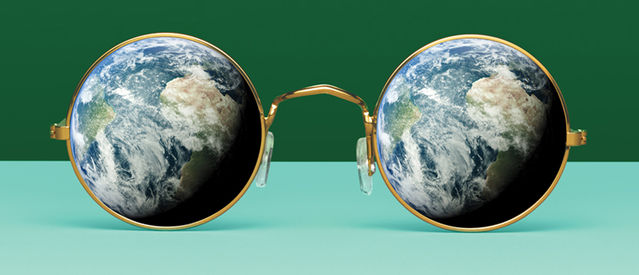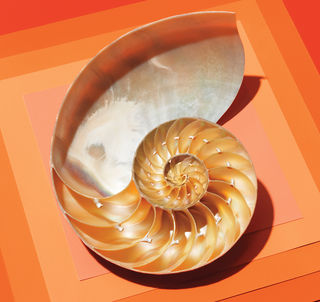It's Not All About You!
Not only will the experience of awe make us feel alive, it might also help us conquer our daily self-absorption. All this by simply paying attention to nature and the world around us.
By Carlin Flora published March 8, 2016 - last reviewed on November 16, 2020

Learning about the universe—and our place in it—is one of the most mind-blowing experiences of childhood (that and realizing parents are just, well, people). Few children go on to explicate nature’s greatest mysteries, but Michio Kaku, now a theoretical physicist and science popularizer, did. When awe first struck him, Kaku was 8 years old, and his teacher had just announced that a great scientist had died. She held up a classic photo of Albert Einstein at his desk and pointed out his unfinished manuscript in the picture. Kaku said to himself, “I want to have a crack at it.” His feeling of awe came not just from the formation of this grandiose goal but from the idea that the universe is knowable. The world might seem unfathomable, he says, but, astonishingly, “you can summarize it on a sheet of paper, using the formulas of physics.”
Physicists struggled to reconcile Einstein’s theory of general relativity with quantum physics. As one of the originators of string field theory—which posits the existence of multiple universes and unknown dimensions, as well as one-dimensional extended objects known as strings—Kaku met his goal of carrying on Einstein’s work. Strings vibrate in space, not unlike the strings on a violin, and when they do, at different frequencies, they manifest as different particles and forces of nature. Gravity, then, would be like an F-sharp, while electro-weak interactions (part of quantum physics) would be like an E-flat. Kaku’s was a sublime achievement, especially for someone from humble and challenging origins—he was the son of a gardener and a maid, both of whom spent time in internment camps during WWII. That first moment of wonder, his youthful epiphany, is, he says, “still the well from which I draw water when I’m tired and need refreshment.”
“There are thousands of papers on string theory,” he says. “Once in a while, one is beautiful.” To a physicist, Kaku says, symmetry is beauty: “It’s turning mounds and mounds of formulas into a simple, elegant, symmetrical equation. It’s symmetry that emerges out of chaos, like a diamond formed after years spent putting together pieces of shattered crystal.” Our drive to seek out beauty in the universe, Kaku says, has allowed humans to probe its most puzzling questions.
This kind of beauty also allows us to zoom the camera lens far out from our tiny settings. “All your selfish little concerns mean nothing next to the grandeur of the universe,” says Kaku. “Awe gives you an existential shock. You realize that you are hardwired to be a little selfish, but you are also dependent on something bigger than yourself. Einstein was a tremendous influence on us because he was a messenger from the stars. We look at the stars and think, ‘My problems are so trivial compared to the majesty of the night sky.’”
Kaku, who explains tricky concepts with witty metaphors and similes, appears on news programs as often as pundits and Hollywood celebrities. His popularity—along with that of colleagues like Neil deGrasse Tyson, TV shows such as The Big Bang Theory that celebrate nerds, and online entities like “I F*cking Love Science” that package scientific delight with an overlay of hipness—reflects our thirst for knowledge. But it also reveals a strong desire for staggering, eye-opening insights, a craving for awe in a jaded world.
The 2015 New Horizons expedition to Pluto, vistas atop the Himalayas, and Michaelangelo’s Creation of Adam ignite intellectual curiosity and provide aesthetic pleasures, but they also pull us out of our default mode of self-absorption and could even be the antidote for our self- (and selfie-) obsessed age, in which taking and posting photos of oneself is a completely acceptable practice. Even solitary artists and thinkers are expected to “brand” themselves and share their private lives with the wider public in order to sell their wares. Cue the “emotion of self-transcendence, a feeling of admiration and elevation in the face of something greater than the self,” as awe is defined by a team of University of Pennsylvania researchers. And recent research shows that in the wake of marvel, people feel more connected to their social groups and motivated to act for the greater good. Wonder pulls us together—a counterforce to all that seems to be tearing us apart.
Depending on your particular interests, you might be stunned by an intricately designed mosaic or, like Kaku, a graceful equation. Paul Piff, assistant professor of psychology and social behavior at the University of California, Irvine, says that though some people are predisposed to feel awe more often than others, there are common elicitors of marvel. “An awe-inspiring thing can be literally large or just conceptually large, but in either case your current understanding or frame of reference can’t accommodate it.” He points to funny videos of babies riding through tunnels for the first time, their faces twisting into confusion and surprise. “No wonder we have the intuitive sense that awe mimics a childlike wonder at the world and all its novelties.” An early magnificent moment for Piff took place when he was 11 and went on a safari in Kenya with his family. “I had no conception of real wildlife. We were in a big national park, and like a cloud morphing across the landscape, thousands of wildebeests charged toward us.”
Robert Leahy, Ph.D., a clinical psychologist, the director of the American Institute for Cognitive Therapy, and the author of The Worry Cure, sees awe as a cousin to appreciation and gratitude, and links these to the experiences often found in places of worship, where architecture, music, and prayer conspire to draw attendees outside of themselves. In a recent paper, Piff and colleagues echo the thought by describing religious institutions as places that “elicit, organize, and ritualize awe.” (A not particularly religious friend of mine recalls walking down the street when, precisely as the sun burst through the clouds, an organ at the nearby church bellowed out a glorious soundtrack. She was wonderstruck.)

Nature, of course, is a frequent awe-generator. “What is the first window into wonder?” asks journalist Richard Louv, the author of The Nature Principle: Reconnecting With Life in a Virtual Age. “It’s crawling out to the edge of the grass, listening to the wind and the trees, turning over a rock, and realizing that you’re not alone in the world.” Louv has come to think that the immune-system boost, improved cognitive functioning (such as increased attention span), and other consequences of being in the great outdoors are all elements of this one essential gift of awe: feeling truly alive.
The link between exposure to nature and well-being is strong. Urbanites are more likely to be anxious and depressed and to suffer from other mental illnesses. But city dwellers who visit nature-rich environments see an immediate reduction in stress hormones. In one of many such studies, Stanford researcher Gregory Bratman found that college students who walked through green, leafy parts of their campus were happier and more attentive afterward than those assigned to hang out near heavy traffic.
A 2014 review study by David Pearson and Tony Craig concluded that the cognitive benefits of being in nature are due to “restorative environments,” which provide the experience of escape from daily demands and a perception of vastness. The authors note that greater attention spans and less mental fatigue are found after people just watch films or view photographs of natural scenes—good news for urbanites who don’t have a chance to flee home. And as long as the key elements of “being away and fascination” are present, monasteries, museums, art galleries, and urban scenes containing water are all suitable alternatives to the countryside.
When anxiety strikes, its sufferers are overwhelmed by, and hyperfocused on, their own worrisome, dark thoughts. It’s a state that infuses an often misleading sense of “realness” or “correctness” to those thoughts, says Leahy.
Rumination—or mulling over worries—is the biggest predictor of depression and anxiety, according to a large-scale British study published in 2013. “Awe is the opposite of rumination,” says Leahy. “It clears away inner turmoil with a wave of outer immensity.” Whether it’s a sunset with colors more vivid than you’ve ever seen or a rapidly expanding sense of love felt when staring into another’s eyes, “being in awe is losing yourself in something or someone else. The anxious person’s sense that ‘it’s all about me; I must control my situation’ disappears.”
Hallucinogenic trips often produce mystical sensations of awe, so it’s perhaps not surprising that in study trials, psilocybin—the active ingredient in “magic mushrooms”—relieved cancer patients’ anxiety and fear of death. Psilocybin can even change people’s personality, making them more open-minded. This kind of awe, researchers speculate, can change the brain’s chemistry over the long haul.
Daniel Smith, the author of Monkey Mind: A Memoir of Anxiety, recalls panicking as a kid in the face of the realization that the universe is overwhelmingly vast—an anxious person could conceivably be made to feel too small by something so big, after all. But lately, looking for wonder has relieved him of “morbid self-involvement.” During a time of personal upheaval, he sought out reverential experiences by sitting under a linden tree near his Brooklyn apartment every day for months.
“I would just hang out there for about 15 minutes and gaze up at its branches,” Smith says. “I needed something to remind me that my concerns were temporary, local, minute. I wasn’t blissed out in a trance, and it wasn’t a cure-all, but it was a very good remedy. The tree is large and old, and it is just wonderful, in a literal sense. It’s a reminder of the kind of strange, ridiculous wonder of creation.” Living in a city full of people with “faces that I have to constantly interpret as friendly or not,” he says, can exhaust a generally anxious person—or any person for that matter. The tree was imposing, yet posed no threat.
At first thought, wonder-as-therapy might seem to be in opposition to standard talk therapy. Seeing a therapist requires focusing on and sharing your thoughts and feelings. It’s an inward dive. As Leahy sees it, though, cognitive behavioral therapy is about, yes, examining your thoughts, but also learning to take them less seriously, to look at how they might be inaccurate or silly or useless, to stop taking what happens around you so personally, to realize it’s not all about you.
Smith also sees chasing awe as complementary to psychotherapy: “Therapy is about finding new perspectives and forming new habits. Learning to seek out amazement is a good habit. And a good therapist is telling you to gaze at your navel to get you to stop gazing at your navel and to actually see what was before unconsidered, or automatic. Therapy helps us accept reality, and awe is a component of reality: It’s a way to remove the tyranny of ego.” As a writer, Smith appreciates how the experience is often sensory, providing a break from hyper-developed verbal capabilities that can “imprison us in the logical world.” Awe leaves us speechless.

A decade ago, when Paul Piff said that he wanted to study the psychology of awe, his mentor cautioned, “Good luck.” While he and other researchers suspected that awe has an impact on human behavior and were well aware of the attention philosophers have given the subject, “it’s a hard thing to stick in a test tube,” he says.
Piff noticed that awe arises in very different contexts—from the ocean’s edge to the hospital birthing room—but he wondered if, even though we often feel it while alone, it could serve an important collective function. When the constant buzzing of “me, me, me” recedes, we might become sensitive to loftier principles. Could awe make us better citizens?
Previous research has shown that awe expands people’s notion of available time, which in turn increases their well-being; that those high in “dispositional” awe are less likely to call themselves “special” and more likely to identify themselves as a member of a group or larger category; and that subjects primed to remember an awe-filled moment in their past feel less significant and less focused on day-to-day concerns.
In their recent set of five experiments, Piff and colleagues hypothesized that if awe does cause pro-social tendencies, the mechanism for doing so is the small self—a “relatively diminished sense of self vis-à-vis something deemed vaster than the individual.” This isn’t smallness in the sense of feeling ashamed or humiliated, Piff says. It’s that relieving notion that “I’m not that important or big, but I am a part of something much bigger.”
Piff found that people who are dispositionally inclined to awe were less selfish. Subjects who saw an awe-inspiring video also identified with the small self more than both those who were induced to feel pride or amusement and those in a control group. They were also more generous (behavior triggered by the small-self state, specifically) than those who watched a humorous video, and they behaved more ethically in lab experiments. Awe-filled subjects helped the study’s investigator pick up more pens that were “accidentally” dropped than did other subjects, for example. In addition, they showed less of a sense of entitlement.
Even those who watched “negative” awe-inspiring videos of tornadoes and volcanoes exhibited the pro-social behavior. So did those who watched a video showing droplets of colored water “colliding with a bowl of milk” in super-slow motion.
The pièce de résistance was the final experiment, where subjects were taken to the tallest hardwood grove in North America. They were asked to look up at the eucalyptus trees, some exceeding 200 feet, for one minute. The control group set their sights on a plain, tall building for the same amount of time. Sure enough, the tree-gazers felt more awe and were happier precisely because of what they felt. They also acted more generously in a lab test and reported feeling less entitled than the building-gawkers.
Why do we tend to find wonder in nature and in contexts that make us feel small, and why does awe stir us to behave more charitably toward others? Evolutionary psychology may provide clues. “It makes sense that beautiful landscapes, or even paintings depicting nature, produce awe,” says Glenn Geher, a professor of psychology at State University of New York at New Paltz, “because people who were well-connected to landscapes, animals, and water sources were more likely to survive.” Survival and, later, achievement have always rested on our creating cohesive non-kinship-based groups. “We needed mechanisms for coordinating these groups,” says Geher, “and a shared belief in something bigger than the individual is an effective one. The catalyst for adopting such beliefs was awe. Awe-inspiring sacred spaces connect expansive emotions with religious iconography.” Because of the cooperation it fostered, “awe has gone on to help us create universities, symphonies, and voyages to the moon.”

Erika Strand, chief of social policy at UNICEF Mexico, has sung in choirs since she was 12. She recalls a performance, with her college choir, of Verdi’s Requiem that stands out years later: “Everything just came together and clicked,” she says. “It starts with the Day of Wrath. Verdi is a sinner, and he’s terrified because it’s Judgment Day. The feeling of fear we conjured was so powerful. The music united all of us with the audience— we all have fears and regret not having been the person we wanted to be—as the piece expresses something so human.”
Strand’s director used to tell his singers that they needed to continually adjust themselves to be perfectly in tune and balanced with each other. “If the choir is a bit flat, you have to make yourself a little flat. If everyone is behind, you have to join them by compromising your pace. And if your voice sticks out, even if it’s pretty, the whole thing is ruined,” says Strand. When the Requiem was over, no one had to say anything—everyone knew they’d nailed it, escaping the mundane and achieving transcendence. “Moments like that give life meaning,” she says.
A few years ago, Jonah Berger and Katherine Milkman, two professors at the Wharton School of Business at the University of Pennsylvania, undertook an elaborate study of the most-emailed articles in The New York Times. Emotional articles in general were often shared, but awe-inspiring pieces topped the list. At the time, Berger explained (in the Times) that the motive for forwarding an awe-inspiring article to family and friends was not to show off or inform them, as might be the case with other types of articles, but rather to seek “emotional communion.” Just as Piff discovered that experiencing awe by ourselves rather paradoxically makes us feel more connected to others, reading to ourselves about beauty compels us to reach out. “If I’ve just read this story that changes the way I understand the world and myself…I want to proselytize and share the feeling of awe. If you read the article and feel the same emotion, it will bring us closer together,” Berger said.
While Piff concurs that vicarious experiences of wonder can be powerful, he suspects that people are drawn to such breathtaking content because we are generally awe-deprived. “We have less time on our hands and fewer windows onto wonder,” he says, pointing to decreased funding for the arts and a decline in attendance at cultural events, increased urbanization, runaway materialism that keeps us working instead of stopping to take in sunshine and an intermittent breeze. Then there’s the attitudinal stance of our time—cynicism. A few recent cases in point: When Mark Zuckerberg and his wife, Priscilla Chan, announced that they would be giving the bulk of their fortune away to charity, commenters wasted no time putting the couple down and questioning their “true” motives. And when a married media executive was cruelly outed by the website Gawker, a longtime leader in snark, for attempting to solicit a prostitute, its publisher reacted to the backlash by asking his scribes to be a mere “20 percent nicer,” a figure he reportedly later adjusted to “10 to 15 percent.”
“It’s an insult to say, ‘That’s sentimental,’” agrees Leahy. “There is almost an enjoyment of making things profane, and all the cynicism takes away our propensity to feel awe.” Louv also points out that irony and cynicism are more aligned with depression and defeatism, as in “been there, done everything.”
Yet we need awe more than ever. Leahy points to research on how young people—a group more anxious than the youth of 40 years ago—are more likely to believe that they must attain special status in life, or even celebrity, to be happy. “Narcissism leads to unrealistic expectations,” he says.
How then, can we tip the seesaw to raise marvel and lessen self-centeredness? Keith Campbell, a professor of psychology at the University of Georgia and the co-author of The Narcissism Epidemic: Living in the Age of Entitlement, finds the idea that awe could reduce narcissism “totally reasonable because awe reduces some aspects of the ego,” and he would like to carry out experiments to test the theory.
Meanwhile, Louv’s primary mission is to create more “nature-rich” parks, schools, and homes. “As of 2008, more people live in cities than in the countryside for the first time in human history,” he says. “Studies of urban parks show that those with the highest biodiversity are the best for our health. We need to bring nature into our lives, not only to slow down the biodiversity collapse, but to make ourselves healthier—mentally, physically, spiritually.” Rather than use completely un-awe-inspiring terms such as “energy efficiency,” “sustainability,” or “survivability,” Louv says, we need to paint a positive, detailed picture of what our planet could be like in the future—in contrast to the postapocalyptic world so resonant with teenagers, as evidenced by the dystopian books and movies they devour (The Hunger Games, Divergent).
Educators would do well to add wonder to their lessons. Kaku says that teens, even those who had life-changing conceptual realizations about the universe as children, often lose interest in science in high school, where postulating hypotheses and collecting data are emphasized. “The scientific method is necessary, of course,” he says, “but at the cutting edge of science, the big breakthroughs and paradigm shifts are rarely based on it. Those come with a lightning bolt, a thunderclap, a moment of awe. That’s what drives the history of science.” Kaku’s passion for cultivating scientific literacy among grown-ups also helps us experience awe, as the more deeply we understand things, the more we have to continually accommodate our current notions of reality—via those exciting cognitive shifts that spark wonder.
Those shifts and their life-affirming, anxiety-quelling, narcissism-squashing, and generosity-upping effects can happen anytime and anywhere, simply by thinking about our world and our universe. Take Kaku’s quest to complete Einstein’s dream of a Theory of Everything: A few years ago, to great fanfare, the Large Hadron Collider in Switzerland found the Higgs boson particle, the first of a series of particles physicists aim to discover. Kaku hopes the Collider will next find evidence of dark matter, an invisible form of matter, and then, eventually, even evidence of parallel universes and higher dimensions, all predicted by string theory. Despite such advancements, though, most of the universe is beyond our current understanding. And all of us here on Earth who are composed of the “higher elements” make up a minuscule percentage of the universe. As Kaku puts it, we are the exception, specks of dust, but ones that, as part of a rare universe with intelligent life, are the byproduct of countless miraculous accidents. Mind. Blown.

How Awestruck Are You?
Ask yourself these questions. Score each item from 1 to 5. If your total reaches 30, then you must be pretty enchanted by the world.
- I often feel awe.
- I see beauty all around me.
- I feel wonder almost every day.
- I often look for patterns in the objects around me.
- I have many opportunities to see the beauty of nature.
- I seek out experiences that challenge my understanding of the world.
Source: Paul Piff
Submit your response to this story to letters@psychologytoday.com. If you would like us to consider your letter for publication, please include your name, city, and state. Letters may be edited for length and clarity.
For more stories like this one, subscribe to Psychology Today.
Facebook/LinkedIn image: Dudarev Mikhail/Shutterstock
